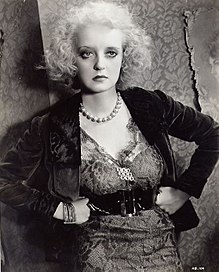Early years in Hollywood (1930–1936)
Davis in her film debut, The Bad Sister (1931)
Carl Laemmle, the head of Universal Studios, considered terminating Davis's employment, but cinematographer Karl Freund told him she had "lovely eyes" and would be suitable for The Bad Sister (1931), in which she subsequently made her film debut.[11] Her nervousness was compounded when she overheard the Chief of Production, Carl Laemmle, Jr., comment to another executive that she had "about as much sex appeal as Slim Summerville," one of the film's co-stars.[12] The film was not a success, and her next role in Seed (1931) was too brief to attract attention.
Universal Studios renewed her contract for three months, and she appeared in a small role in Waterloo Bridge (1931) before being lent to Columbia Pictures for The Menace and to Capital Films for Hell's House (all 1932). After nine months, and six unsuccessful films, Laemmle elected not to renew her contract.
Davis was preparing to return to New York when actor George Arliss chose Davis for the lead female role in the Warner Brothers picture The Man Who Played God (1932), and for the rest of her life, Davis credited him with helping her achieve her "break" in Hollywood. The Saturday Evening Post wrote, "she is not only beautiful, but she bubbles with charm," and compared her to Constance Bennett and Olive Borden.[13] Warner Bros. signed her to a five-year contract, and she remained with the studio for the next eighteen years, garnering great acclaim for herself as well as making a fortune for her employers.
In 1932 she married Harmon "Ham" Nelson, who was scrutinized by the press; his $100 a week earnings compared unfavorably with Davis's reported $1,000 a week income. Davis addressed the issue in an interview, pointing out that many Hollywood wives earned more than their husbands, but the situation proved difficult for Nelson, who refused to allow Davis to purchase a house until he could afford to pay for it himself.[14] Davis had several abortions during the marriage.[15]
As the shrewish Mildred in Of Human Bondage (1934), Davis was acclaimed for her dramatic performance
The film was a success, and Davis's confronting characterization won praise from critics, with Life magazine writing that she gave "probably the best performance ever recorded on the screen by a U.S. actress."[17] Davis anticipated that her reception would encourage Warner Bros. to cast her in more important roles, and was disappointed when Jack L. Warner refused to lend her to Columbia Studios to appear in It Happened One Night, and instead cast her in the melodrama Housewife.[18] When Davis was not nominated for an Academy Award for Of Human Bondage, The Hollywood Citizen News questioned the omission and Norma Shearer, herself a nominee, joined a campaign to have Davis nominated. This prompted an announcement from the Academy president, Howard Estabrook, who said that under the circumstances "any voter ... may write on the ballot his or her personal choice for the winners," thus allowing, for the only time in the Academy's history, the consideration of a candidate not officially nominated for an award.[19] Claudette Colbert won the award for It Happened One Night but the uproar led to a change in Academy voting procedures the following year, whereby nominations were determined by votes from all eligible members of a particular branch, rather than by a smaller committee,[20] with results independently tabulated by the accounting firm Price Waterhouse.[21]
Davis appeared in Dangerous (1935) as a troubled actress and received very good reviews. E. Arnot Robertson wrote in Picture Post, "I think Bette Davis would probably have been burned as a witch if she had lived two or three hundred years ago. She gives the curious feeling of being charged with power which can find no ordinary outlet." The New York Times hailed her as "becoming one of the most interesting of our screen actresses."[22] She won the Academy Award for Best Actress for the role, but commented it was belated recognition for Of Human Bondage, calling the award a "consolation prize."[23] For the rest of her life, Davis maintained that she gave the statue its familiar name of "Oscar" because its posterior resembled that of her husband, whose middle name was Oscar,[24][25] although her claim has been disputed by the Academy of Motion Picture Arts and Sciences, among others.
In her next film, The Petrified Forest (1936), Davis co-starred with Leslie Howard and Humphrey Bogart, but Bogart, in his first important role, received most of the critics' praise. Davis appeared in several films over the next two years but most were poorly received.



No comments:
Post a Comment